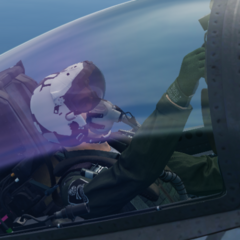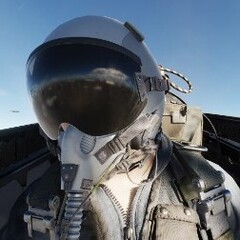Leaderboard
Popular Content
Showing content with the highest reputation on 02/13/09 in all areas
-
The AH-64A Apache - A Swedish perspective Since 1988 the Swedish army has operated two companies of what it refers to as 'anti-tank' helicopters - 20 MBB BO 105CBs (local designation Hkp 9A) equipped with the Emerson Heli-TOW system. In March 1995 the Chief of the Army requested the Director of Army Aviation to undertake a technical demonstration programme of a dedicated attack helicopter. In 1996 Sweden was facing a major defence review and the army felt the time was at hand to evaluate its requirement for, and the benefits of, a modern multi-role attack helicopter. A list of potential types was drawn up for evaluation, including the MDH AH-64A Apache, Bell AH-1W Super Cobra, Agusta A 129 Mangusta, Eurocopter Tiger, Atlas/Denel CSH-2 Rooivalk, Mil Mi-28 'Havoc' and Kamov Ka-50 'Hokum'. The primary purpose of the evaluation was to determine how aircraft would perform in a Swedish environment, so the army insisted that its pilots be trained to fly each type under evaluation, and act as systems operators/gunners. Aircraft had to be available for evaluation in mid-1995, undertake live weapons firings and require a minimum of operating/ support costs. The choice was narrowed to the AH-64A and Mi-28. The Swedes recognised that one was a mature system and the other still in the early stages of development, but were interested in examining the two completely different design philosophies and doctrines behind the Apache and the 'Havoc'. Planning for the four-week evaluation began in April/May 1995. Upon arrival in Sweden the aircraft would self-deploy to the Northern Military District to undertake tactical missions and live-firing exercises. This would be followed by air-to-air target firing and tactical missions in the Central and Southern Military Districts. As a result, each aircraft would be exposed to the full range of Swedish geography and climate. The Swedish Defence Material Administration (FMV) and the United States Army Security Command, with the support of the Swedish Army Aviation Centre and McDonnell Douglas Helicopters, agreed to supply two USAREUR AH-64As, then stationed in Hanau. A Swedish crew was trained by MDH at Mesa to fly the Apache and operate its systems. A team of Swedish tactical advisors travelled to Ft Rucker to undertake detailed mission planning. The two Apaches (86-9029/86-9033) were flown from Germany by a mixed US/Swedish crew, arriving at the 2nd Army Aviation Battalion in Linkoping on 12 August 1995. The Apaches were scheduled to undertake a range of tactical scenarios, including operational redeployment between military districts, avoiding enemy fighter aircraft, engagement of enveloping forces, deep strike operations, operations in the Swedish archipelago, engagement of enemy air assault forces, delaying operations against mechanised forces, and supporting attacking armoured forces. Swedish terrain, tactics and military posture mean that standard US operational procedures, such as artillery and air support, were impossible. The Swedes learned that the Apache had the flexibility to operate throughout the country and could be redeployed over substantial distances while still carrying an effective weapons load. Even without the use of EW systems, the Apaches avoided the JA 37 Viggens of F21 Wing, which were hunting them during their redeployments. In the event, missions were not flown at night, although the Swedes recognise that night operations are preferable, indeed essential, in their Arctic environments (in northern Sweden six months of the year are spent in almost permanent darkness). The autonomous nature of AH-64A operations stretched Sweden's (substantial) C3 network and highlighted the need for an improved communications fit on the aircraft. The Apache's radios are not compatible with Swedish radio systems. Two days of maritime operations with navy and marine units in the archipelago proved that the Apache was very vulnerable on the outer coastline and needed the shelter of the inner archipelago to protect it from hostile fire. However, the Marines were impressed by the AH-64A and thought that the Apache could play an important role in supporting (or repelling) amphibious attacks. Furthermore, the Hellfire missile (Rb 17) is already in service as a coastal defence weapon in Sweden and is compatible with the Apache's own weapons. During a simulated air drop by an air force Hercules, the Apaches 'shot down' the aircraft using Hellfire. During anti-armour missions the Apache proved to be far superior to Sweden's existing Hkp 9As. Air-to-air trials were conducted against towed targets at the Swedish Anti-Aircraft School, Vaddo. The targets were 'cold' (with no IR signature, perhaps not the most realistic simulation) and the FLIR and DVO were unable to acquire them within the prevailing safety limits. When the gun did lock-up a target the autotracking system failed and no direct hits were ever made on any target. Live-firing trials were limited to the Apache's rocket system, as Sweden already has the Hellfire in service (as a coastal defence missile) and is familiar with its performance. There were also cost and safety factors in this decision. A manual rocket firing was made and the rockets missed the target area by several hundred meters. A total of 99 hours was flown by the two aircraft during the four-week evaluation. During that time, there were periods when one or both AH-64As were unserviceable. The Apaches suffered from software problems in the FCC and badly maintained rocket pods; an APU clutch had to be changed, a TV camera had to be replaced, a laser unit had to be replaced, several bulbs had to be changed, one gun suffered a hardware failure and rotors needed repairing. As a result, five of the planned 20 missions were cancelled due to technical problems. Additional missions were also cancelled to allow ground crews more time to prepare for weapons tests. The Apache's navigation and fire control systems suffered several problems. Co-ordinates in latitudes higher than 65°N could not be entered and, as a result, planned night attack missions were not flown. A single Mi-28 was supplied by Rosvoorouzhenie to the FMV under a contract signed in August 1995. The evaluation helicopter (Mi-28 prototype 042) was airlifted by II-76 to Lulea on 7 October 1995. Using Mi-24s and Mi-28s in Moscow, the Swedes had trained one test pilot and two service pilots to fly the Mi-28. Swedish personnel ultimately flew as weapons systems operators during the evaluation, and not as command pilots (the Mi-28 does not have dual controls). Since the Russian pilot was not a fluent English speaker, all operational missions were tightly pre-briefed and flown with a translator airborne in another aircraft. The Mi-28 flew a number of tactical missions that mirrored the Apache programme. The Swedish evaluation found that the sighting system worked well and was easy to use, even in the hands of an inexperienced crew. The Mi-28 was rated as highly survivable, with good ballistic protection for the crew and with an extensive onboard RWR and ECM system. The MMI (Man Machine Interface/ergonomics) of the Mi-28 was generally good and will be improved. The aircraft handled well, although crews had some reservations about their early production standard aircraft in this area. Current production Mi-28s are completely lacking in any nightfighting capability. Mil is working to remedy this problem with the much improved Mi-28N, which has been compared (perhaps over-optimistically) to the AH-64D. The official Swedish Army Aviation Centre report on the evaluation stated that the Mi-28's weapons accuracy was "good and astonishingly repeatable," particularly taking into account the range of firing parameters and poor weather conditions. Both 9M1154Shturmand 9M120 Ataka guided missiles were fired against stationary targets (to a maximum range of 4680 m/15,354 ft, with the Mi-28 flying at 200 km/h, 124 mph IAS), with 1-m (3.3-ft) accuracy. Rockets were found to be accurate up to a range of 4000m (13,123ft), with 35 hits registered from 40 firings. Four unexploded rockets were later found and questions were raised about the production quality and safety standards of Russian ammunition. Gun firings were unsuccessful due to bad boresighting. The Mi-28 was flown for a total of 30 hours, never failed to undertake a mission, and experienced the minimum of technical snags. On one occasion an engine automatically throttled back The AH-64A maintained its reputation as an complex and effective aircraft during the Swedish army aviation evaluation. after plume ingestion from a rocket firing. This was a safety measure which performed as expected, and the aircraft was ready for flight within an hour, to resume firing tests. The aircraft also experienced a failure of the flare dispenser. The Swedish opinion of the Mi-28 was that it was a robust and reliable helicopter well-suited to field conditions. Reservations were expressed about the classification and standards of its electrical system and some design features. Integration of the required modern avionics would require additional electronic shielding and filtering. Availability of the necessary specifications, airworthiness certification, technical manuals and maintenance documentation was an unknown. The evaluation of the AH-64A concluded that it was a highly-complex aircraft, requiring a well-trained and co-ordinated crew. Successful missions demanded an intensive level of mission planning. Its onboard systems allowed detection of targets, by day and night, at ranges meeting all Swedish requirements. A large proportion of Swedish wartime personnel are drawn from a (trained) conscript force, who were deemed to be capable of supporting Apache operations. The attack helicopter demonstration programme to date has provided much first-hand experience and broadened the Swedish understanding of modern attack helicopter operations. The programme will continue through to 1999/2000, with a view to presenting a final proposal, prior to the next major Parliamentary defence review in 2001. An AH-64D Longbow Apache evaluation will take place during that timeframe. A Eurocopter Tiger evaluation was scheduled for February 1997. Robert Hewson2 points
-
In Russian: http://www.digitalcombatsimulator.com/index.php?lang=ru&end_pos=2320&scr=default In English: http://www.digitalcombatsimulator.com/index.php?lang=en&end_pos=2320&scr=default Coming soon?1 point
-
hope you guys arent tired of me... im done with pitbuilding for now...im trying to work my way to flying the shark more... this week i am finishing up my right arm panel controller stack (that has a touchscreen computer, and a modified saitek aviator) at the moment, i am just tryign to finish the custom touchbuddy profile.. i just have to work on 2 more tabs (lighting and views) and configure the keys and im done done..1 point
-
Sorry if this has been posted already. I did a few searches but I didn't see anything. http://ptyxiouxos.net//greekbotics/user_projects/Flight_Simulator/thanos_home_motion_flight_simulator.htm This is a motion simulator based on the old JoyRider plans (http://www.acesim.com/main.html). The guy has added windscreen wiper motors and his own pc interface to drive the motion. The components are cheap and readily available. The main materials are PVC pipe and mechano type strips of metal. It looks complex, but if you look into his walkthrough of the construction you will see its surprisingly easy. The interface is on his site as well. You just need to print out the circuit board and solder the required components. Few choice youtube videos: LiveForSpeed:- This one is good, as it shows some of the latest features to be added. Lots more shaking and "turbulence" to the motions. F16:- This video shows the ranges of the simulator. IMO this thing would be ideal for Black Shark. I'm going to start on mine during the summer, I cant bloody wait.:pilotfly:1 point
-
Bug fixes and added x45 support. http://www.saitekforum.com/showthread.php?t=166431 point
-
The first batch of 24 MiG-29SMTs originally destinted for Algeria (but not delivered) are now being delivered to the Russian Air Force. The airframes returned from Algeria are undergoing maintenance and are also scheduled to move to the Russian AF soon. Two aircraft were delivered to the Lipetsk test center and at least 10 are being delivered to an operational regiment in Kursk. Lipetsk birds: credit for the above photo - Antoha at www.airforce.ru IMHO - these are the finest combat aircraft in the Russian AF today. Too bad they are so few...1 point
-
You won't notice a significant difference unless you really compare complex manuevers with FD on and OFF. ZaltysZ is correct in his observation. Try two level, constant speed, constant bank, Coordinated 360 turns--one turn with FD on and one with FD off. Remember two things: 1) FD On = Autopilot off (except dampening functions), 2) FD Off with trim held is essentially the same as FD On but with no cyclic neutral point--which makes it a little less precise then flying with FD on. Smokin' Hole1 point
-
evasive manouvers my friend ! guns guns guns jink flare flare jink flare flare jink flare flare .... sort of like this i guess should work. and i yes before i forget sticking to the 300/300 rule. will indeed be very interesting to see how it works1 point
-
Indeed! Which begs the question - is one gonna get clubbed with equal contempt as at present with the Kamov if one ventures too close to one of them? (IFV's and the like, that is) At present any closer than, what, 3.5 clicks or so and they start haemmorhaging TOW's my way.......:gun_sniper:1 point
-
In due time. ;) And as you can tell from my sig, i am already planning out the movie (to a certain extent of course..)1 point
-
Although the designers forgot to put a QWERTY keyboard in the plane, what is this an early 80's home micro with that alphabetical layout?!?! :)1 point
-
1 point
-
For those who think this missile will save you from dogfight:) Im sure there is flares developed that will give a flash away to blind the Aim-9x and future optic guided missiles. Or mutch more smoke to fly in. NOTE: there is no tailsmoke from the Aim-9x.1 point
-
*drool* This deserves a smileyspam: :drunk::beer::cheer3nc::worthy::yay::clap_2::shocking::thumbup:1 point
-
Another major consideration is that the games of today, as complex as they are, cost far more to develop than those of the 90's. It's standard today for major titles to have development budgets in the tens of millions, something that was almost unfathomable just a decade ago. Despite this, game prices have remained relatively fixed. In fact, for this reason we're probably getting more value for our money today than we did back then, despite the lack of beefy manuals.1 point
-
1 point
-
Думаю боевые летчики, оставшиеся в живых именно благодаря броне 25-го, подобными вопросами не задаются, только благодарны конструкторам машины. )1 point
-
Именно, только катапульта, воспользовавшись которой пилот станется жив. А без брони, катапульта ему уже не понадобится в большинстве случаев. А вообще уважаемый, ты просто не умеешь штурмить, т.к. грач живучая машина, и даже после попадания очереди из зенитной установки, да и ракеты, самолет остается летабелен, иногда даже боеспособный, но это уже реже. К слову, ястребы, которые в игре сверхманевренные, гораздо быстрее выводятся из строя при попадании снарядов, а при попадании УР, сразу труп. При этом, увернутся от этих самых снарядов/ракет не намного проще. В игре что бы отстрелить все плоскости грачу, нужно достаточно много попаданий, учись уворачиваться.1 point
-
on another note: I think this guys was trying to stop, what do you guys think :D http://www.patricksaviation.com/photos/browse/recent/?p=21 point
-
1 point
-
Если возможность срубить летчика из пулемета существует на малых высотах то почему бы самолету не добавить скорости и маневрености т.е. пристрелить сразу двух зайцев : 1 Способность вести маневренный бой не только с наземными но и своздушным противником . 2 Быстро набирая скорость после атаки наземных целей, исключать возможность попадания наземного противника в пилота путем кидания в последнего лапатой !1 point
-
I would suggest to be overcautious and deactivate before making any hardware upgrade.1 point
-
64 Bit version is now mirrored here: http://rapidshare.com/files/197444018/SD6_64_Software_6_6_2_0.exe.html :)1 point
-
1 point
-
Great stuff, keep em coming, I cant tell you how much i enjoy playing the user created missions. Soooo cooool! Thanks snake, I need MP missions. Cant wait to try these out! Reputation comin your way!1 point
-
1 point
-
Я ее накрыл вообще до того как она рванула от дома.. просто домик уже развалился. И я решил обработать прилегающую территорию для гарантии. Но потом долго охотился за машинками на дороге =) Я ж не знал что уже 100% набил. Вообщем итог два камаза и 1 легковушка.... а нечего по ночам ездить. Неудобно как то вышло =)1 point
-
Yeah, but there are some who have already said to me, "You shouldn't use outside views," to which I would respond, "It's not my fault you're willing to give up the wonder of this game's scenic beauty!" I would actually rather have a reset trimmer, but trimmed to the 7* or whatever it is. I like things customized to how I'd use it, and that would be a boon for me. I will keep an eye out to see if I can figure out, or hear something about how to do it. It might have been in the FAQ that I read that about sitting on the runway being default pitched differently than level flight (or taking off). I know that for a while, that nose-pitch-back-thing was driving me crazy when I first took off. By the way, , what are you talking about? We are all new to this game. It has been available for only a month or so (or only a couple if you went Russian). I think we are all still learning a lot. Well, maybe not the beta-testers, but I tend to think everyone else is still pretty new!1 point
-
1 point
-
Recently Browsing 0 members
- No registered users viewing this page.





